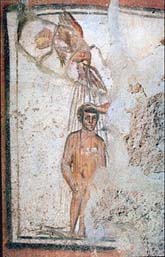|
| |

Baptism. Fresco on the catacomb of Saints Marcellinus and Peter, Via Labicana, Rome,
Italy
A brief summary of Infant Baptism.
In Christian religious practice, infant baptism is the baptism of young children or infants. In theological discussions, the practice is sometimes referred to as paedobaptism or pedobaptism from the Greek pais meaning "child." The practice is sometimes contrasted with what is called "believer's baptism," or credobaptism, from the Latin word credo meaning "I believe", which is the religious practice of baptizing only individuals who personally confess faith in Jesus, therefore excluding small children.
Most Christians practice infant baptism. Roman Catholics, Eastern Orthodox, Oriental Orthodox, Assyrian Church of the East, Anglicans, Lutherans, Methodist, Church of the Nazarene, Reformed Church in America, Episcopalians, United Church of Christ (UCC), Presbyterians, Continental Reformed), and others, baptize infants. Together, these constitute over 80% of all those who call themselves
Christians.
Numerous denominations within the Protestant tradition—including Mennonites, Amish, Plymouth Brethren, Baptists, Pentecostals, Seventh-day Adventists, Non-denominational churches, and other Arminian denominations—reject infant baptism, as do Jehovah's Witnesses, Christadelphians, and Latter-day Saints.
Ceremony.
The exact details of the baptismal ceremony vary among Christian denominations. Many follow a prepared ceremony, called a rite or liturgy. In a typical ceremony, parents bring their child to their congregation's priest or minister. The minister then applies water to the child. As the water touches the child, the minister utters the words "I baptize you in the name of the Father, and of the Son, and of the Holy Spirit" (See Matthew 28:19).
Most Christians baptize their baby by either pouring water (affusion) or by sprinkling water (aspersion) on the child. Some Eastern Orthodox and Roman Catholic traditions baptize their babies by totally immersing them in the font.
Although it is not required, many parents and godparents chose to dress their baby in a white gown called a christening gown for the baptism ceremony. Christening Gowns often become treasured keepsakes that are used by many other children in the family and handed down from generation to generation. Traditionally, this gown is white or slightly off white and made with many laces, trims and intricate details. In the past, a gown was used for both baby boys and girls. In more modern times, it has become appropriate to baptize boys in christening outfits. Also made of white or off white fabric, the christening outfit consists of a romper with a vest or other accessories. After the baptism ceremony, these articles of clothing are preserved as a memory of this very special and significant event in the child's life.
History.
Scholars disagree on the date when infant baptism was first practiced. Some believe that first-century Christians did not practice
it. Others believe that they did, understanding biblical references to individuals "and [their] whole household" being baptized (Acts 16:15, Acts 16:31-33) as including small children and infants.
While the earliest extra-biblical directions for baptism, which occurs in the Didache (c.
100), seems to envisage the baptism of adults, rather than young children, since it requires that the person to be baptized should
fast, writings of the second and early third century indicate that Christians baptized infants
too. Irenaeus (c. 130–202) speaks not only of children but even of infants being "born again to
God" and three passages of Origen (185–c. 254) mention infant baptism as traditional and
customary. Tertullian (c. 155–230) too, while advising postponement of baptism until after marriage, mentions that it was customary to baptize infants, with sponsors speaking on their
behalf. The Apostolic Tradition, attributed to Hippolytus of Rome (died 235), describes how to perform the ceremony of baptism; it states that children were baptized first, and if any of them could not answer for themselves, their parents or someone else from their family was to answer for
them.
Some writers who believe that baptism of infants began to be practiced only after the first century - in the third century it was certainly the universal practice and was believed to be of apostolic
origin - posit a link between it and the use of baptism by methods other than immersion, methods which, in spite of the evidence of the Didache, some claim did not at all exist in the first century.
From at least the third century onward Christians baptized infants as standard practice, although some preferred to postpone baptism until late in life, so as to ensure forgiveness for all their preceding sins. The belief that people baptized as infants needed to be rebaptized arose only in the sixteenth
century.
**Information acquired from Wikipedia.com** |
